Entropy Analysis of the Flat Tip Leakage Flow with Delayed Detached Eddy Simulation
Abstract
:1. Introduction
2. Numerical Methods
2.1. Governing Equations
2.2. Turbulence Model
2.3. Delayed Detached Eddy Simulation
2.4. Flow Solver
3. Computational Setup
4. Validation and Comparison of DDES and URANS
Comparison of URANS and DDES Results
5. Analysis of the Flow Structures
6. Modal Analysis and the Loss Mechanism
6.1. Proper Orthogonal Decomposition Analysis
6.2. Loss Analysis
6.2.1. Distribution of Entropy Generation Rate
6.2.2. Losses Due to Steady and Unsteady Effects
7. Conclusions
Author Contributions
Funding
Conflicts of Interest
Abbreviations
| h | blade span, mm |
| Ca | blade axial chord, mm |
| C | blade chord, mm |
| density, kg/m | |
| p | blade pitch, mm |
| P | pressure, Pa |
| total pressure, Pa | |
| total pressure at inlet, Pa | |
| velocity at mid-span, m | |
| T | temperature, K |
| s | entropy, kJ/(kg·K) |
| projection of the vorticity, s | |
| dissipation, kJ/(s·m) | |
| tip clearance height, mm | |
| relative inlet flow angle, ° | |
| m | inlet mass flow rate, kg/s |
| IQ | index of quality |
| Cp0 | total pressure coefficient |
| TKE | turbulent kinetic energy, m/s |
| EGR | normalized entropy generation rate |
| Svis | viscous entropy generation rate |
| Sthe | thermal entropy generation rate |
| viscous stress, kJ/m | |
| deformation, s |
References
- Sjolander, S.A.; Amrud, K.K. Effects of Tip Clearance on Blade Loading in a Planar Cascade of Turbine Blades. J. Turbomach. 1987, 109, 237–244. [Google Scholar] [CrossRef]
- Moore, J.; Tilton, J.S. Tip leakage flow in a linear turbine cascade. J. Turbomach. 1988, 110, 18–26. [Google Scholar] [CrossRef]
- Yaras, M.I.; Sjolander, S.A. Prediction of Tip-Leakage Losses in Axial Turbines. J. Turbomach. 1992, 114, 204–210. [Google Scholar] [CrossRef]
- Tallman, J.; Lakshminarayana, B. Numerical Simulation of Tip Leakage Flows in Axial Flow Turbines, with Emphasis on Flow Physics: Part I?Effect of Tip Clearance Height. J. Shenyang Jianzhu Univ. 2000, 123, 817–824. [Google Scholar]
- Zhou, K.; Zhou, C. Aerodynamic Interaction between an Incoming Vortex and Tip Leakage Flow in a Turbine Cascade. J. Turbomach. 2018, 140, 111004. [Google Scholar] [CrossRef]
- Li, J.; Du, K.; Song, L. Effects of tip cavity geometries on the aerothermal performance of the transonic turbine blade with cavity tip. Proc. Inst. Mech. Eng. Part A J. Power Energy 2016, 230. [Google Scholar] [CrossRef]
- Kang, D.B.; Lee, S.W. Effects of squealer rim height on heat/mass transfer on the floor of cavity squealer tip in a high turning turbine blade cascade. Int. J. Heat Mass Transf. 2016, 99, 283–292. [Google Scholar] [CrossRef]
- Yang, D.; Feng, Z. Tip Leakage Flow and Heat Transfer Predictions for Turbine Blades. Proc. ASME Turbo Expo 2007, 4, 589–596. [Google Scholar]
- Senel, C.; Maral, H.; Kavurmacioglu, L.; Camci, C. An aerothermal study of the influence of squealer width and height near a HP turbine blade. Int. J. Heat Mass Transf. 2018, 120, 18–32. [Google Scholar] [CrossRef]
- Lee, S.W.; Joo, J.S. Heat/mass transfer over the cavity squealer tip equipped with a full coverage winglet in a turbine cascade: Part 2? Data on the cavity floor. Int. J. Heat Mass Transf. 2017, 108, 1264–1272. [Google Scholar] [CrossRef]
- Park, J.S.; Lee, D.H.; Rhee, D.H.; Kang, S.H.; Cho, H.H. Heat transfer and film cooling effectiveness on the squealer tip of a turbine blade. Energy 2014, 72, 331–343. [Google Scholar] [CrossRef]
- Ma, H.; Zhang, Q.; He, L.; Wang, Z.; Wang, L. Cooling Injection Effect on a Transonic Squealer Tip Part I: Experimental Heat Transfer Results and CFD Validation. J. Eng. Gas Turb. Power 2017, 139, 052506. [Google Scholar] [CrossRef]
- Ma, H.; Zhang, Q.; He, L.; Wang, Z.; Wang, L. Cooling Injection Effect on a Transonic Squealer Tip Part II: Analysis of Aerothermal Interaction Physics. J. Eng. Gas Turb. Power 2017, 139, 052507. [Google Scholar] [CrossRef]
- He, K. Investigations of Film Cooling and Heat Transfer on a Turbine Blade Squealer Tip. Appl. Therm. Eng. 2017, 110, 630–647. [Google Scholar] [CrossRef]
- Stefano, C.; Shahrokh, S. Enter Multi-Disciplinary Analyses for The Design of a High Pressure Turbine Blade Tip. In Proceedings of the ASME Turbo Expo 2016: Turbomachinery Technical Conference and Exposition, Seoul, Korea, 13–17 June 2016. [Google Scholar]
- Stefano, C.; Shahrokh, S.; D, C.J. Numerical investigations of different tip designs for shroudless turbine blades. Proc. Inst. Mech. Eng. Part A J. Power Energy 2016, 230. [Google Scholar] [CrossRef]
- Du, K.; Li, Z.; Li, J. Numerical Investigation of the Blade Tip and Overtip Casing Aerothermal Performance in a High Pressure Turbine Stage. In Proceedings of the ASME Turbo Expo 2016: Turbomachinery Technical Conference and Exposition, Seoul, Korea, 13–17 June 2016; p. V05AT13A011. [Google Scholar]
- Kelly, R.; Jemcov, A.; Cameron, J.D.; Morris, S.C.; Coffman, J.; Malak, M.F. GT2017-64979 Very Large Eddy Simulation (VLES) of a Squealer Tipped Axial Turbine Stage. In Proceedings of the Igti Turbo Expo, Charlotte, NC, USA, 26–30 June 2017. [Google Scholar]
- Lumley, J.L. The structure of inhomogeneous turbulence. In Atmospheric Turbulence & Wave Propagation; Yaglom, A.M., Tatarski, V.I., Eds.; Nauka: Moscow, Russia, 1967. [Google Scholar]
- Aubry, N.; Holmes, P.; Lumley, J.L.; Stone, E. The dynamics of coherent structures in the wall region of a turbulent boundary layer. J. Fluid Mech. 1988, 192, 115–173. [Google Scholar] [CrossRef]
- Ma, X.; Karniadakis, G.E. A low-dimensional model for simulating three-dimensional cylinder flow. J. Fluid Mech. 2002, 458, 181–190. [Google Scholar] [CrossRef]
- Moehlis, J.; Smith, T.R.; Holmes, P.; Faisst, H. Models for turbulent plane Couette flow using the proper orthogonal decomposition. Phys. Fluids 2002, 14, 2493–2507. [Google Scholar] [CrossRef]
- Bizon, K.; Continillo, G.; Mancaruso, E.; Merola, S.S.; Vaglieco, B.M. POD-based analysis of combustion images in optically accessible engines. Combust. Flame 2010, 157, 632–640. [Google Scholar] [CrossRef]
- Dalibor, C.; Erik, M.K. LES of turbulent jet in cross flow: Part 2 – POD analysis and identification of coherent structures. Int. J. Heat Fluid Flow 2012, 36, 35–46. [Google Scholar]
- Unai, F.; Macarena, G.; Tomas, C.; Enrico, S. Computational Modeling of Gurney Flaps and Microtabs by POD Method. Energies 2018, 11, 2091. [Google Scholar]
- Spalart, P.R.; Allmaras, S.R. A one-equation turbulence model for aerodynamic flows. In Proceedings of the 30th Aerospace Sciences Meeting and Exhibit, Reno, NV, USA, 6–9 January 1992. [Google Scholar]
- Spalart, P.R.; Deck, S.; Shur, M.L.; Squires, K.D.; Strelets, M.K.; Travin, A. A New Version of Detached-eddy Simulation, Resistant to Ambiguous Grid Densities. Theor. Comput. Fluid Dyn. 2006, 20, 181. [Google Scholar] [CrossRef]
- Su, X.; Yamamoto, S.; Yuan, X. On the accurate prediction of tip vortex: Effect of numerical schemes. In Proceedings of the ASME Turbo Expo 2013, San Antonio, TX, USA, 30 December 2013. [Google Scholar]
- Su, X.; Sasaki, D.; Nakahashi, K. On the efficient application of weighted essentially nonoscillatory scheme. Int. J. Numer. Methods Fluids 2013, 71, 185–207. [Google Scholar] [CrossRef]
- Gou, J.; Zhang, Y.; Su, X.; Yuan, X. Numerical investigation on the effects of real industrial bleeding geometry in a high-speed compressor stage. J. Mech. Sci. Technol. 2016, 30, 5275–5286. [Google Scholar] [CrossRef]
- Lin, D.; Yuan, X.; Su, X. Local Entropy Generation in Compressible Flow through a High Pressure Turbine with Delayed Detached Eddy Simulation. Entropy 2017, 19, 29. [Google Scholar] [CrossRef]
- Menter, F.R. Two-equation eddy-viscosity turbulence models for engineering applications. AIAA J. 1994, 32, 1598–1605. [Google Scholar] [CrossRef] [Green Version]
- Shur, M.; Spalart, P.R.; Strelets, M.; Travin, A. Detached-eddy simulation of an airfoil at high angle of attack. Eng. Turbul. Model. Exp. 1999, 4, 669–678. [Google Scholar]
- Su, X.; Yuan, X. Implicit solution of time spectral method for periodic unsteady flows. Int. J. Numer. Methods Fluids 2010, 63, 860–876. [Google Scholar] [CrossRef]
- Vatsa, V.N.; Carpenter, M.H.; Lockard, D.P. Re-evaluation of an Optimized Second Order Backward Difference (BDF2OPT) Scheme for Unsteady Flow Applications. In Proceedings of the 48th AIAA Aerospace Sciences Meeting, Orlando, FL, USA, 4–7 January 2010. Number 20100002944. [Google Scholar]
- Wang, H.; Lin, D.; Su, X.; Yuan, X. Entropy analysis of the interaction between the corner separation and wakes in a compressor cascade. Entropy 2017, 19, 324. [Google Scholar] [CrossRef]
- Li, X.s.; Li, X.l. All-speed Roe scheme for the large eddy simulation of homogeneous decaying turbulence. Int. J. Comput. Fluid Dyn. 2016, 30, 69–78. [Google Scholar] [CrossRef]
- Javier, J.; Parviz, M. The Minimal Flow Unit in Near-Wall Turbulence. J. Fluid Mech. 2006, 225, 213–240. [Google Scholar]
- Poinsot, T.; Lele, S. Boundary conditions for direct simulations of compressible viscous flows. J. Comput. Phys. 1992, 101, 104–129. [Google Scholar] [CrossRef]
- Pope, S.B. Ten questions concerning the large-eddy simulation of turbulent flows. New J. Phys. 2003, 6, 35. [Google Scholar] [CrossRef]
- Pope, S.B. Turbulent Flows; Cambridge University Press: Cambridge, UK, 2000. [Google Scholar]
- Pinnau, R. Model Reduction via Proper Orthogonal Decomposition; Springer: Berlin/Heidelberg, Germany, 2008; pp. 95–109. [Google Scholar]
- Denton, J.D. Loss Mechanisms in Turbomachines. Trans ASME J. Turbomach. 1993, 115, V002T14A001. [Google Scholar] [CrossRef]
- Bejan, A. A Study of Entropy Generation in Fundamental Convective Heat Transfer. J. Heat Transf. 1979, 101, 718. [Google Scholar] [CrossRef]
- Adeyinka, O.B.; Naterer, G.F. Entropy-based metric for component-level energy management: application to diffuser performance. Int. J. Energy Res. 2010, 29, 1007–1024. [Google Scholar] [CrossRef]
- Mohammadreza, H.; Rad, S.; Goodarz, A.; B, D.M.; N, K.S.; R, S.M.; Emad, S. Numerical Study of Entropy Generation in a Flowing Nanofluid Used in Micro- and Minichannels. Entropy 2013, 15, 144–155. [Google Scholar] [Green Version]
- Jin, Y.; Herwig, H. Turbulent flow and heat transfer in channels with shark skin surfaces: Entropy generation and its physical significance. Int. J. Heat Mass Transf. 2014, 70, 10–22. [Google Scholar] [CrossRef]



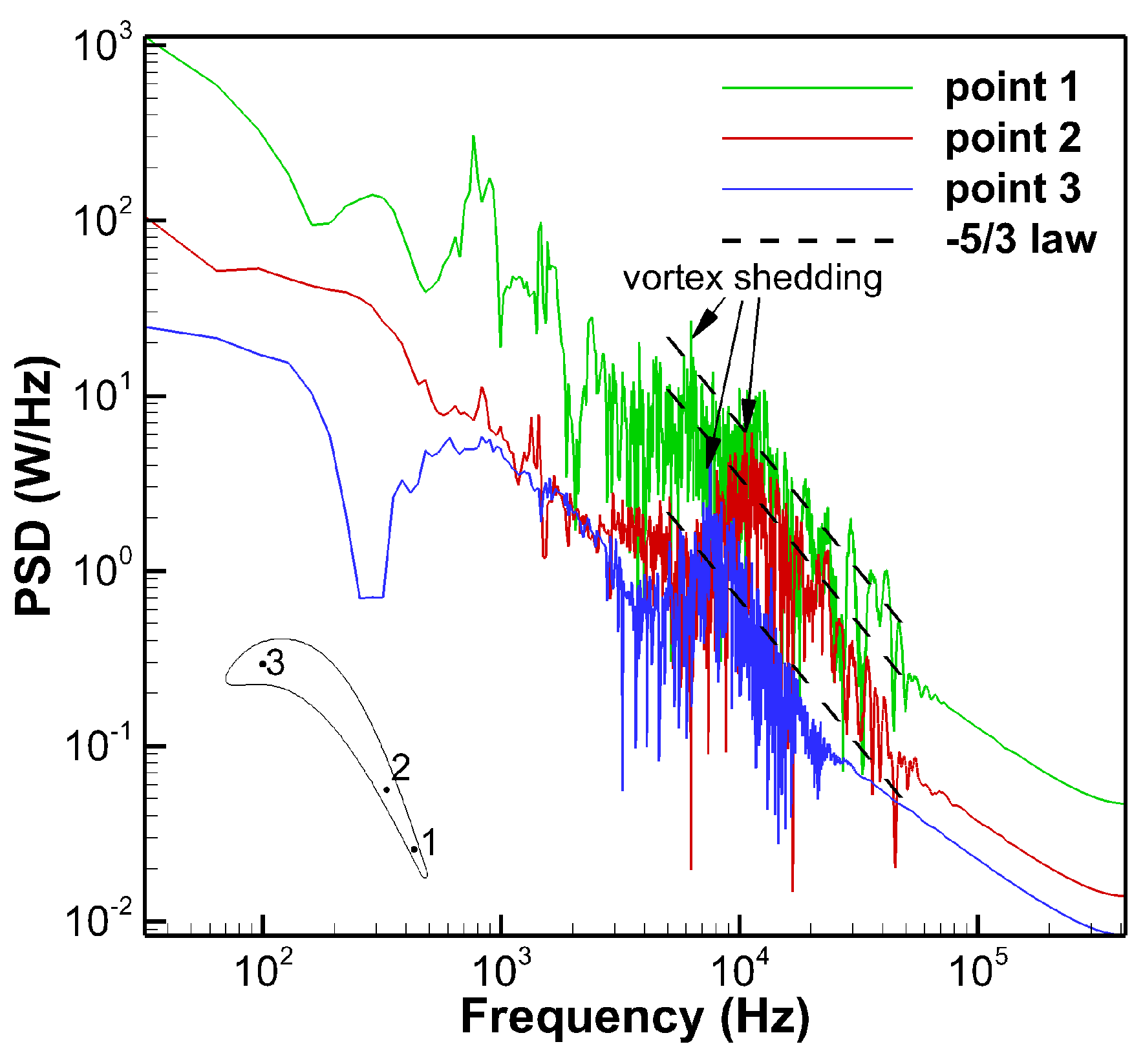


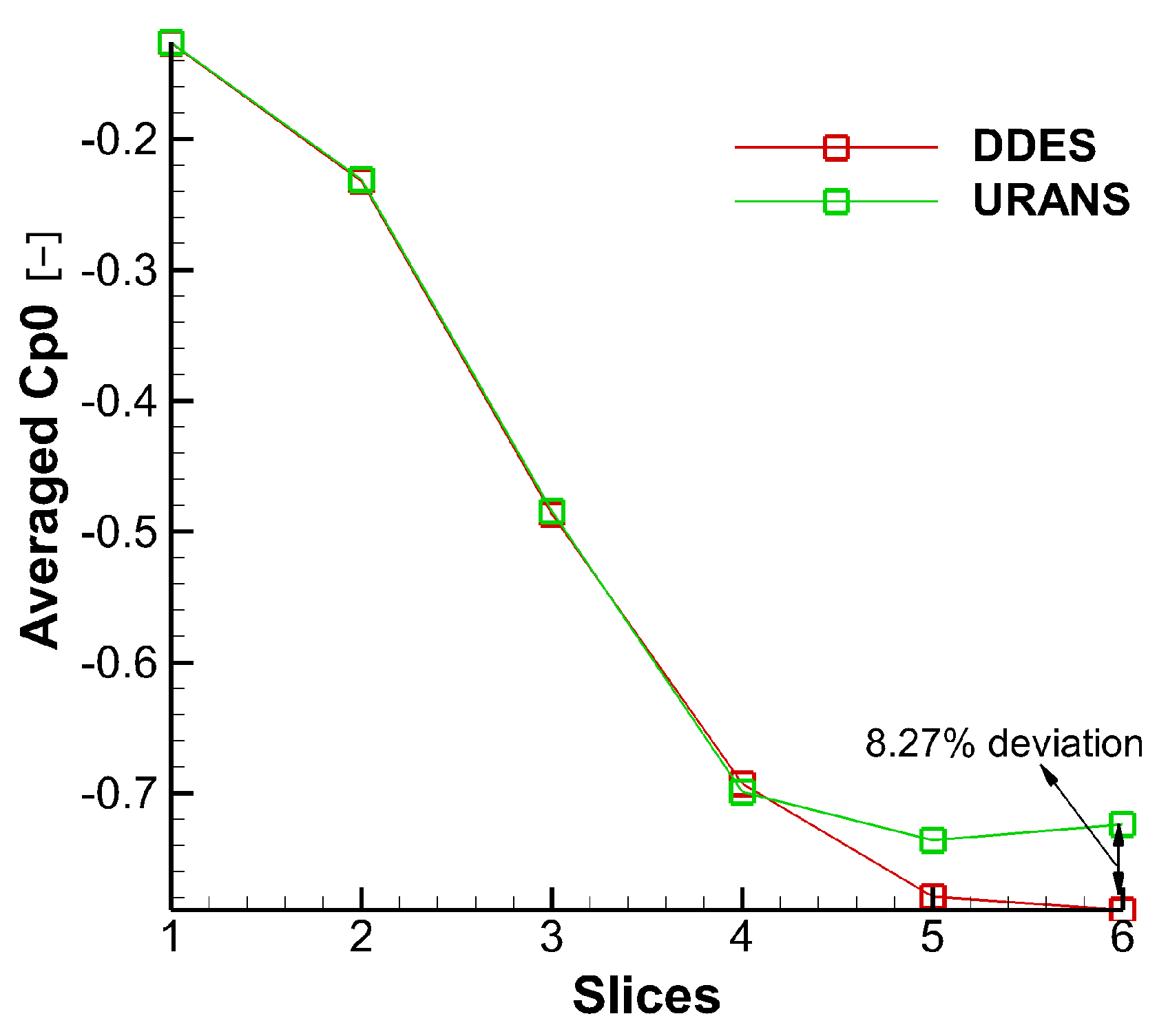
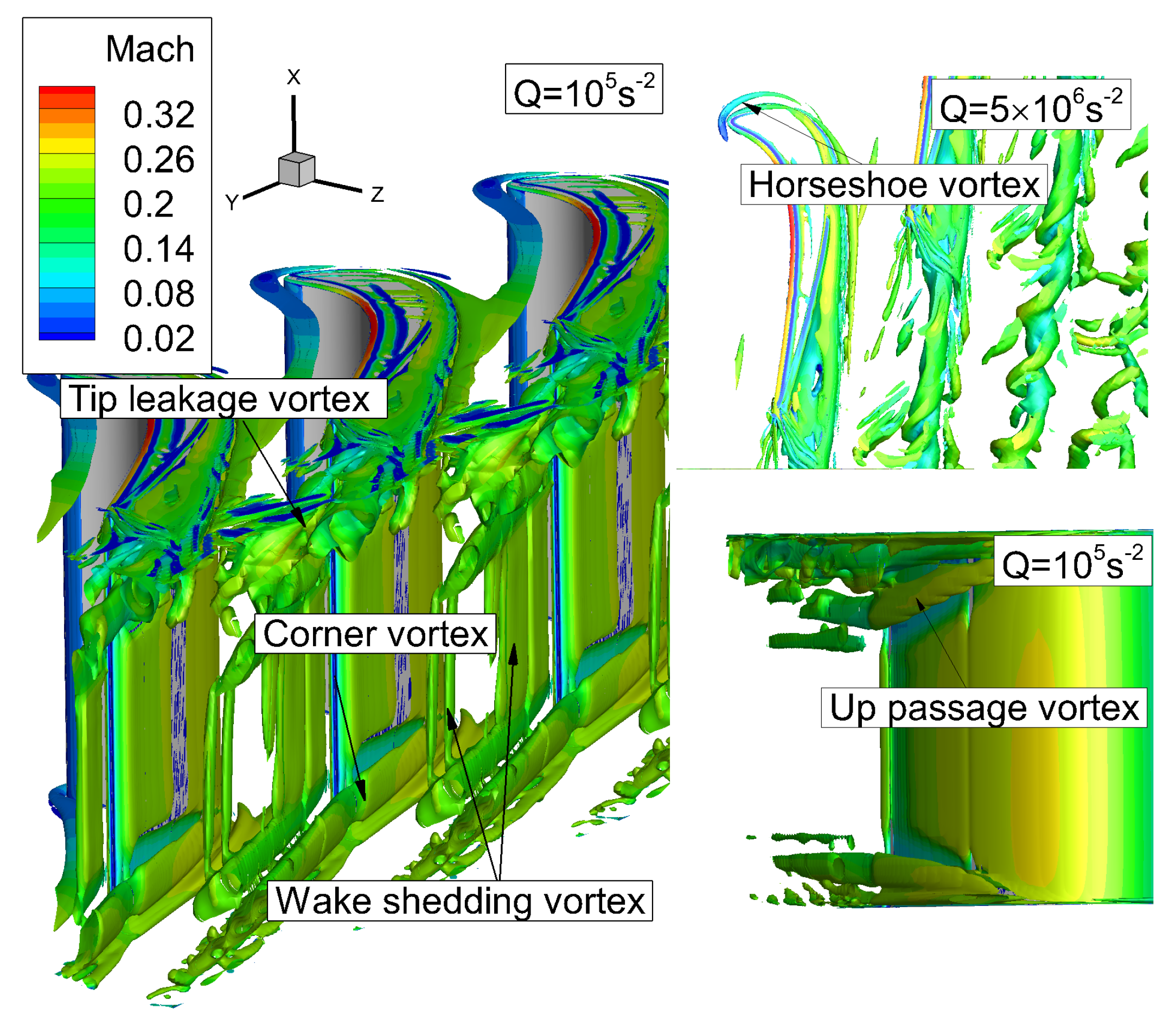



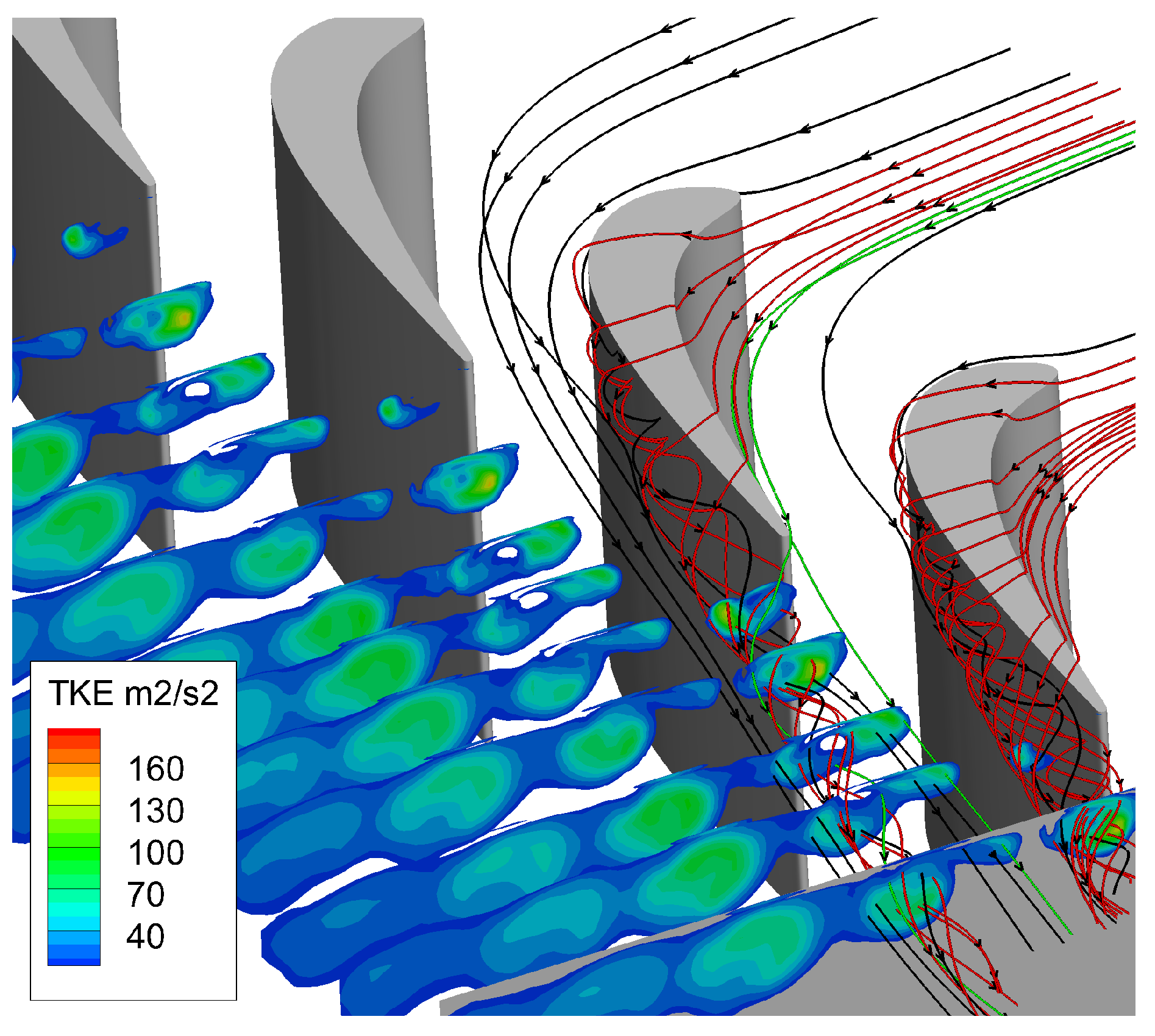







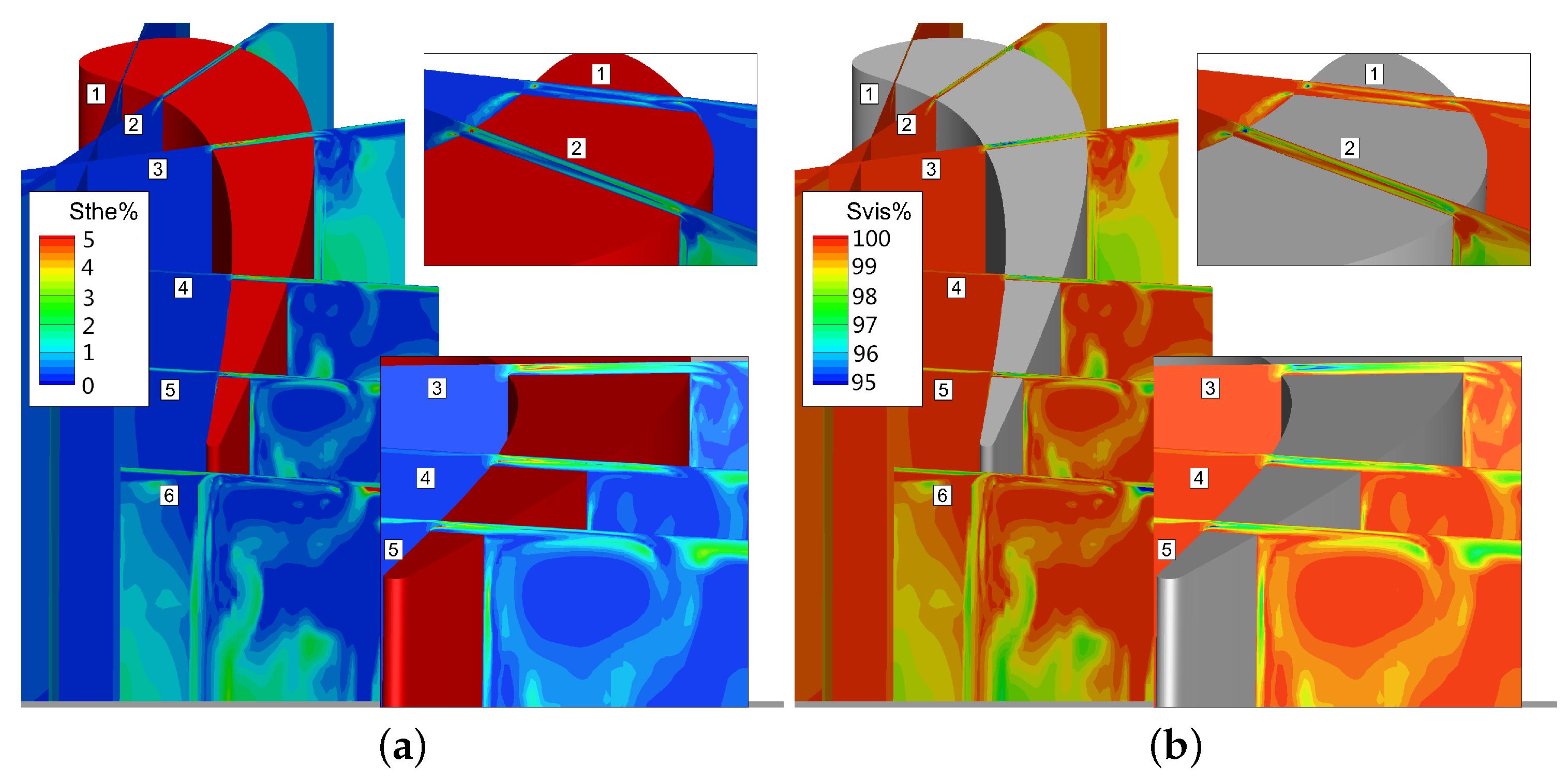
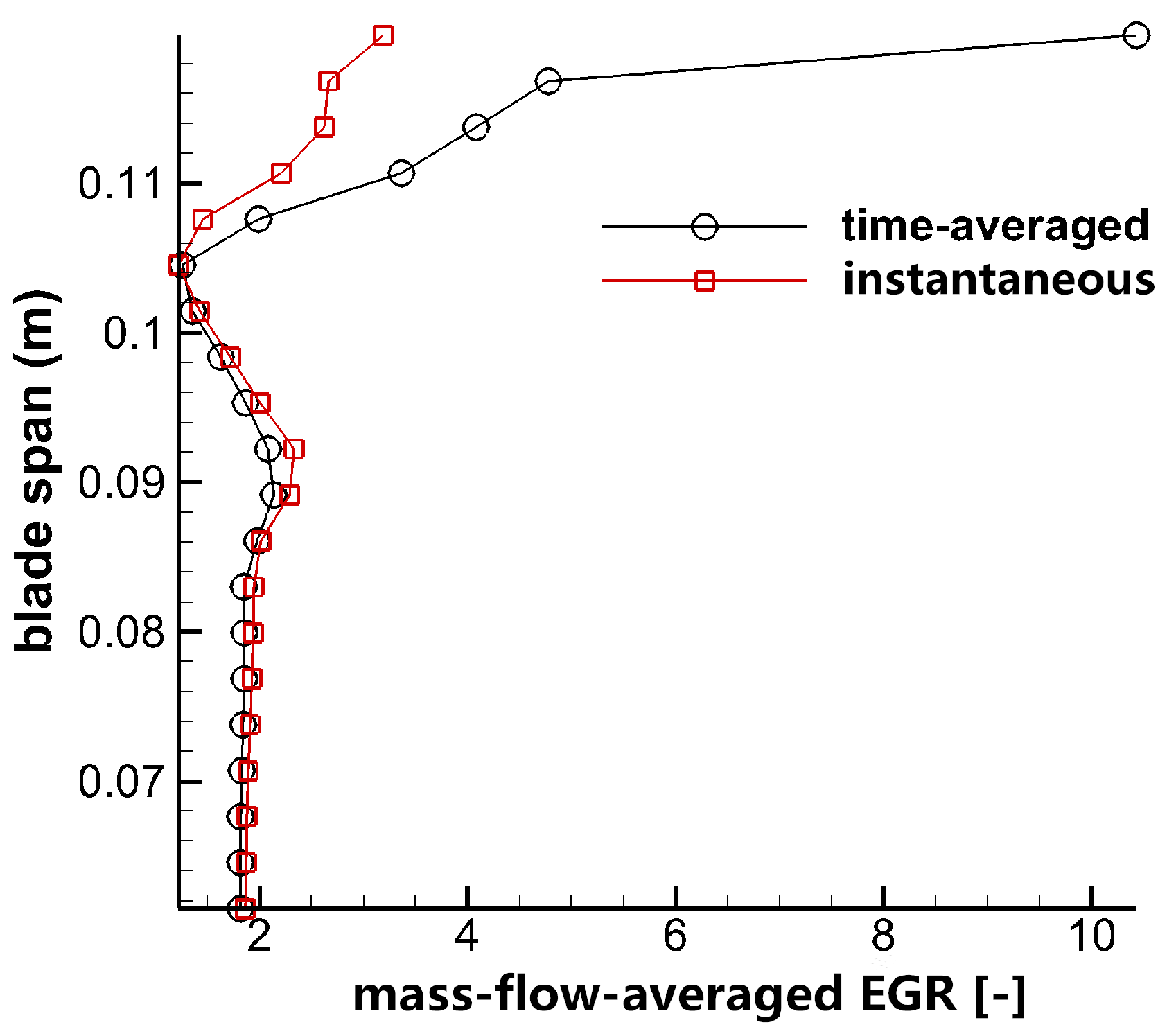


| Parameter | Value |
|---|---|
| Blade Span, h | 123 mm |
| Blade Axial Chord, Ca | 0.69 h |
| Blade Pitch, p | 0.8 h |
| Tip Gap Height, | 0.01 h |
| Relative Inlet Flow Angle, | 20 |
| Inlet Reynolds number | 230,000 |
© 2018 by the authors. Licensee MDPI, Basel, Switzerland. This article is an open access article distributed under the terms and conditions of the Creative Commons Attribution (CC BY) license (http://creativecommons.org/licenses/by/4.0/).
Share and Cite
Li, H.; Su, X.; Yuan, X. Entropy Analysis of the Flat Tip Leakage Flow with Delayed Detached Eddy Simulation. Entropy 2019, 21, 21. https://doi.org/10.3390/e21010021
Li H, Su X, Yuan X. Entropy Analysis of the Flat Tip Leakage Flow with Delayed Detached Eddy Simulation. Entropy. 2019; 21(1):21. https://doi.org/10.3390/e21010021
Chicago/Turabian StyleLi, Hui, Xinrong Su, and Xin Yuan. 2019. "Entropy Analysis of the Flat Tip Leakage Flow with Delayed Detached Eddy Simulation" Entropy 21, no. 1: 21. https://doi.org/10.3390/e21010021





